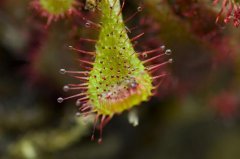Where does pitcher plant originate and how to reproduce? Can pitcher plants digest when eating insects?
The main producing area of pitcher plant is tropical Asia. Do you know anything about pitcher plants? Do you want to know about it? Let's take a look.

How to reproduce pitcher plants?
Pitcher plants are mainly propagated by "cutting". The cutting of pitcher plant is very easy, and the success rate is very high. When cutting pitcher plants, cut the stem of a pitcher plant with a knife; the stem must have two nodes, or in other words, the stem must have two leaves. Because the new buds of pitcher plants grow from the nodes, if the cutting branches do not have nodes, they will not be able to grow new buds. The cultivation medium used for cutting pitcher plants should be water-retaining, such as water moss or peat soil.
Because the cutting branches have no roots, the plants will die for lack of water. In order to prevent the branches from losing water, the following two points must be done:
■ reduces the area of leaves
Because the leaves will lose water, reducing the area of the leaves can reduce the loss of water. Therefore, the petiole on the cutting branch must be cut off, even if there is a large, beautiful bottle on the petiole, it must be willing to cut off. If the branch is too long, it will bring too many leaves and lose water, so two or three nodes on the branch will be enough, not too long.
■ increases Environmental humidity
If the humidity of the environment is very high, the moisture loss of cutting branches can be reduced. Therefore, the branches should be cultivated in an airtight environment, such as wrapping the branches with flowerpots in plastic bags, so as to increase the humidity of the environment.
Put the cuttings in a bright place, but direct sunlight is strictly prohibited, otherwise it will be too hot. After that, about a few months later, if new buds grow on the nodes of the branches, they will be successful; after the leaves grow out, they can be taken care of in accordance with the general mode of cultivation.
Will pitcher plants blossom?
Pitcher plants will blossom, but it is not very easy to blossom. Pitcher plants must grow to a certain size before they blossom. However, because many pitcher plants are propagated by cuttings, the plants are not large enough and must be planted for several more years before they can bloom. In addition, there should be sufficient light and adequate supply of nutrients to make the plant grow strong before it will blossom.
Pitcher plants are dioecious plants, and male and female flowers will grow from different plants. therefore, if you want pitcher plants to bear seeds, you must determine the sex of the pitcher plants you own. Unless you want the pitcher plant to bear seeds, you don't have to care too much about whether the pitcher plant blossoms or not; the flowers of the pitcher plant are not beautiful, and they smell bad and smelly.
Why does the pitcher plant catch insects that don't seem to be digested?
Pitcher plant is a kind of insectivorous plant that can catch insects very well. we can often send the bodies of hundreds of ants in a bottle. However, the appearance of the insect corpses looks quite complete, as if the pitcher plant did not digest the insects.
In fact, these insects have been digested, leaving only their shells. All insectivorous plants can only secrete protein enzymes, which can only decompose insect proteins, so protein-rich tissues in insects can be broken down by protein enzymes, and the main component of the insect's shell is chitin. Insectivorous plants do not produce related enzymes to break down this component, so the digested insects still leave their shells, creating the false impression that the insects have not been digested.
- Prev

What are the insectivorous plants? Is felt moss eating insects an insectivorous plant?
Insectivorous plants are a kind of little-known horticultural plants, which have insectivorous characteristics different from ordinary plants, plus some misunderstandings, do you know which insectivorous plants there are? Pitcher plant: a structure used to capture insects and is specialized at the end of a leaf.
- Next

Where is the nutritional value of onions? Are green onions? what are the nutrients of green onions?
Many people think that green onions are green onions, but they are not. There is a difference between the two. Do you know the nutritional value of onions? Let's take a look. Green onions contain calcium, vitamin C, carotene, dietary fiber and other nutrients, 100 grams of green
Related
- A one-day flower show brings 130 million yuan in orders! Nanhai, this Phalaenopsis exhibition is amazing
- What do the flower language and meaning of Lutheran tree mean? Precautions for planting Lutheran tree
- Encounter Chaoshan Kongfu tea, not without this cup of Phoenix single clump
- The durian market in Vietnam and Thailand is flooded. The price of imported durian has plummeted by 30-40% in a month.
- Shanghai solved the problem of local vegetable supply by planting 80,000 mu of green leafy vegetables.
- Wageningen University has become the best agricultural university in the world for the seventh time in a row.
- The strongest export season of South African grapes is full of challenges, with exports to Russia falling sharply by 21%.
- Sri Lanka is on the verge of bankruptcy, "Tea for debt" Organic Agriculture Revolution aggravates the Food crisis?
- Turning waste into earthworm manure and worm manure into organic fertilizer-A new choice for auxiliary farming
- Organic rice growers shoulder the responsibility of nurturing agricultural talents! Yinchuan Sustainable Farm with Organic Life Camp

